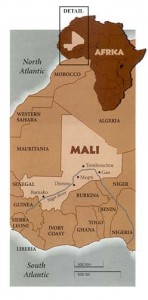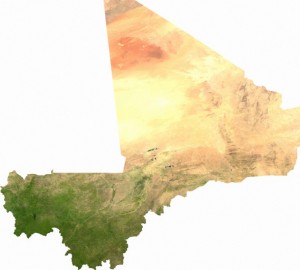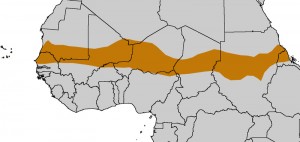Sahara, Sahel and Savanna, Ca Va?
 Mali is an interesting country, and not just because it is shaped like a lopsided butterfly.
Mali is an interesting country, and not just because it is shaped like a lopsided butterfly.
Once the seat of the aptly named Mali Empire of the Middle Ages and briefly under French colonial rule from the end of the 19th century until its independence in 1960, Mali is home to both a diversity of culture and landscape that make it a unique place to visit.
Comprised of a variety of ethnic groups, from the famed and feared Tuareg desert nomads of Timbuktu in the north to the unique Dogon cliff dwellers in the southeast, Mali also geographically straddles the 3 main African climates: Sahara, Sahel and Savanna.
This satellite map of Mali provides a useful visual reference:

You can see clearly see the desert nothingness of the Sahara in the north. With very few exceptions (the Tuareg being one), nobody actually lives in the desolation of the Sahara. And in the south, the greenery of subtropical savanna. The patch in the middle running along the southeast part of the country, which forms the transition between the two, is called the Sahel, a narrow strip crossing the entire continent of Africa:

Unlike the Sahara, the Sahel is livable. Although, frankly, not easily. Or comfortably. Transition it may be, but it looks and feels like the Sahara to the uninitiated during the dry season: desertlike and unbearably hot throughout the year. The difference is that the Sahel does get some rainfall during Africa’s wet season, and thus shrubs, farming and some seasonal rivers and irrigation is possible.
Subtropical savanna (grasslands with scattered trees) starts directly below the Sahel, from suspiciously sandy and desert-like next to the Sahel to progressively greener and lusher the further south one travels. On the eastern part of the continent, for instance, most have heard of the famed savanna grasslands of the Serengeti.
Adding flavor to all three climates is the Harmattan, strong trade winds that blow south out of the Sahara from November to March. Varying in intensity daily and even hourly, these winds carry fine particles of dust (and, when stronger, actual sand) that create the effect of a light haze to outright heavy fog, covering all in its path with dust and sand.
During this winter season, I was surprised to discover that the Harmattan haze completely swallowed sunrises and sunsets. In the mid-afternoon, even on a completely cloudless day, the sun would simply dissipate into the Harmattan haze and a slow progressive dusk would overtake until the darkness of actual sunset several hours later.
Harmattan haze at my side, it’s time to venture forth deeper into the Sahel.
 Click to subscribe via RSS feed
Click to subscribe via RSS feed

Isn’t Earth magical?
lol, indeed. Although when you’re out baking in said desert sometimes the magic you wish for is shade, a nice breeze and an ice box of cold drinks.